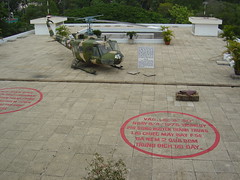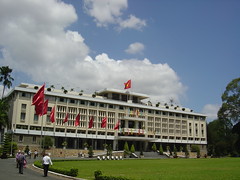The Reunification Palace is a frozen-in-amber reminder of the years of the Republic of Vietnam. This building in particular is emblammatic of that era. Originally named Independence Palace, it was built in 1966 after the original French colonial building on the site was severly damaged in an assassination attempt on President Ngo Dinh Diem. It ceased being a working government building when North Vietnamese tanks stormed the grounds, symbolizing the collapse of South Vietnam.
The English language tour gives a fairly unbiased history of both the building and South Vietnamese politics. The architecture is Modernist along Frank Lloyd Wright lines with subtle to the point being undetectable Asian accents. The original 1960's and '70's era decor and furnishings give the place the air of a slightly mildewed Austin Powers set.

The building itself has developed some mythology around it including the the bad feng shui of the site and the folklore of some poached elephant tusks in the presidential office.
The tableau on the roof has the helicopter that Nguyen Van Thieu used to survey battlefield conditions and marks the locations where two dud bombs dropped by a South Vietnam Air Force defector fell through the roof. Had either bomb detonated, the building would likely have been destroyed.

No comments:
Post a Comment